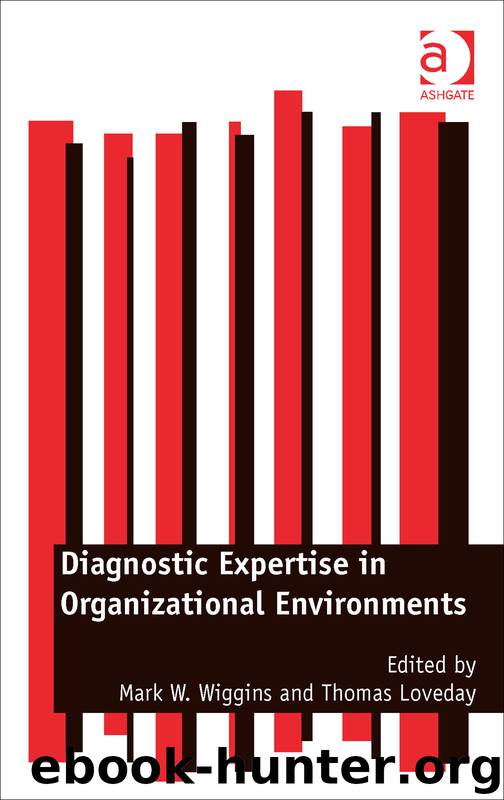Diagnostic Expertise in Organizational Environments by Mark W. Wiggins & Thomas Loveday

Author:Mark W. Wiggins & Thomas Loveday
Language: eng
Format: epub
Publisher: Ashgate Publishing Limited
Published: 2015-03-14T16:00:00+00:00
Cues in Major Crime Investigations
In the context of decision-making, major crime investigation is a relatively unique domain since the aim is to identify a potential suspect on the basis of a series of features that are evident as part of a criminal act. For instance, it often requires the capacity to identify key features associated with a crime scene, as well as the capacity to associate these features with the features of the offender (Douglas, Burgess, Burgess, & Resller, 2013).
The notion of linking features of a crime with features of an offender is largely based on behavioural consistency across certain types of offences, and associations between configurations of offence behaviours and offenders’ background characteristics (Beutler, Hinton, Crago, & Collier, 1995; Canter, 2000; Canter & Fritzon, 1998; Green, Booth, & Biderman, 2001; Grubin, Kelly, & Ayis, 1997). Salfati and Canter (1999) found evidence for consistency in associations between crimes and offenders across 82 stranger-perpetrated homicides. For example, they demonstrated that murderers who stole non-identifiable property, and acted to minimise forensic evidence left at a scene, were more likely to have had a custodial sentence, and/or to have served time in the military.
The most frequently cited associative model of major crime investigations was developed for the Behavioural Analysis Unit of the Federal Bureau of Investigation (United States). This process, referred to as Criminal Investigative Analysis, involves an initial crime scene assessment whereby the investigator seeks out salient crime scene indicators (Douglas et al., 2013). For example, Hazelwood and Napier (2004) identified several indicators that are intended to aid investigators in the diagnosis of a staged crime scene (e.g., evidentiary items removed from the victim). Indicators like these, which are generally embedded in features relating to the forensic findings, victimology, and the criminal act itself, will often provide the investigator with information indicative of the offender’s characteristics (e.g., age, sex, occupation, residential location, etc.). As indicators trigger the retrieval of associated information from memory, it is presumed that they are largely consistent with the conceptualization of cues in the decision-making literature. Further, it is reasonable to suggest that the number of cues in any given crime scene could be large, presenting a challenge to investigators to identify those features that are of most relevance in deriving inferences about the offender. Therefore, consistent with experts in other domains, expert investigators may be better equipped to recognise and engage the most valid and diagnostic cues available.
Santilla, Korpela, and Häkkänen (2004) tested whether experienced investigators of motor vehicle-related crimes were better able than novices to diagnose links in a series of crimes. Participants were asked to think aloud while attempting to link 10 series of three vehicle-related crimes. The authors reported that experienced investigators who had domain-specific knowledge about car-related crimes performed more accurately compared to inexperienced investigators. In relation to cue-use, experienced investigators consistently focussed their attention on a select subset of features, engaging significantly fewer features during decision-making, compared to their inexperienced counterparts. This is consistent with previous findings that have shown that experts
Download
This site does not store any files on its server. We only index and link to content provided by other sites. Please contact the content providers to delete copyright contents if any and email us, we'll remove relevant links or contents immediately.
The Secrets of Successful Financial Planning by Dan Gallagher(1517)
A Knight's Reward by Catherine Kean(1328)
An American Sickness by Elisabeth Rosenthal(1249)
Against the Gods by Peter L. Bernstein(1102)
FREAKONOMICS by levitt steven d(1087)
America's Bitter Pill: Money, Politics, Backroom Deals, and the Fight to Fix Our Broken Healthcare System by Steven Brill(1074)
SuperFreakonomics by Steven D. Levitt(1074)
America's Bitter Pill by Steven Brill(1051)
The Globetrotter's Guide to Travel Insurance: Travel Smarter, Pay Less, Get the Right Coverge (The Savvy Traveler Series Book 1) by Bauche Michael & Bauche Yvonne(1024)
Risk Management Framework by James Broad(1024)
A Practical Introduction to Security and Risk Management by Bruce Oliver Newsome(1022)
2019 Social Security & Medicare Facts by Michael D. Thomas(1016)
Strategic Risk Taking: A Framework for Risk Management by Aswath Damodaran(1011)
The New Frontier Investors by Jagdeep Singh Bachher Adam D. Dixon & Ashby H. B. Monk(1005)
Game Changers by Rudolf Taschner(1002)
How Our Days Became Numbered: Risk and the Rise of the Statistical Individual by Dan Bouk(992)
The 8 Characteristics of the Awesome Adjuster by Carl van Lamsweerde(928)
SUPERFREAKONOMICS by levitt steven d(922)
The Advisor Playbook: Regain Liberation and Order in your Personal and Professional Life by Duncan MacPherson & Chris Jeppesen(885)
